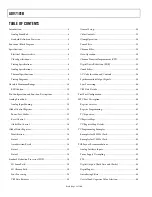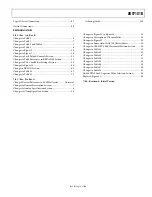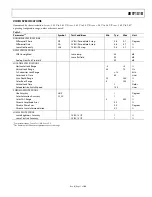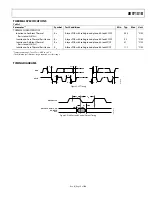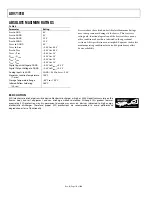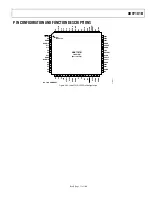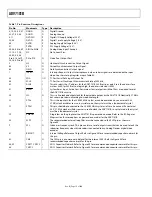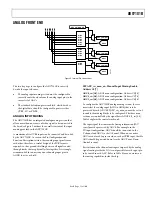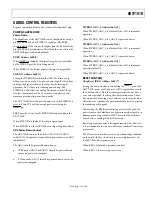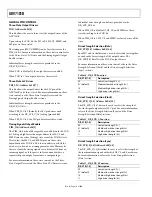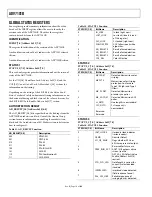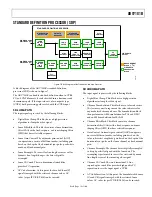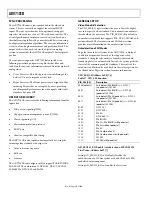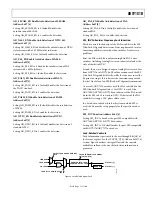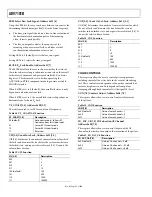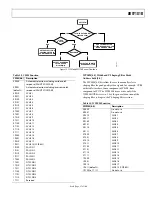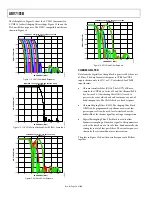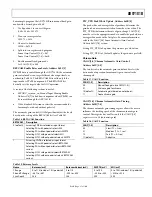
ADV7181B
Rev. B | Page 16 of 100
GLOBAL PIN CONTROL
Three-State Output Drivers
TOD, Address 0x03[6]
This bit allows the user to three-state the output drivers of the
ADV7181B.
Upon setting the TOD bit, the P15 to P0, HS, VS, FIELD, and
SFL pins are three-stated.
The timing pins (HS/VS/FIELD) can be forced active via the
TIM_OE bit. For more information on three-state control, refer
to the Three-State LLC Driver and the Timing Signals Output
Enable sections.
Individual drive strength controls are provided via the
DR_STR_XX bits.
When TOD is 0 (default), the output drivers are enabled.
When TOD is 1, the output drivers are three-stated.
Three-State LLC Driver
TRI_LLC, Address 0x1D[7]
This bit allows the output drivers for the LLC pin of the
ADV7181B to be three-stated. For more information on three-
state control, see the Three-State Output Drivers and the
Timing Signals Output Enable sections.
Individual drive strength controls are provided via the
DR_STR_XX bits.
When TRI_LLC is 0 (default), the LLC pin drivers work
according to the DR_STR_C[1:0] setting (pin enabled).
When TRI_LLC is 1, the LLC pin drivers are three-stated.
Timing Signals Output Enable
TIM_OE, Address 0x04[3]
The TIM_OE bit should be regarded as an addition to the TOD
bit. Setting it high forces the output drivers for HS, VS, and
FIELD into the active (driving) state even if the TOD bit is set.
If set to low, the HS, VS, and FIELD pins are three-state
dependent on the TOD bit. This functionality is useful if the
decoder is to be used as a timing generator only. This may be
the case if only the timing signals are to be extracted from an
incoming signal, or if the part is in free-run mode where a
separate chip can output, for instance, a company logo.
For more information on three-state control, see the Three-
State Output Drivers and the Three-State LLC Driver sections.
Individual drive strength controls are provided via the
DR_STR_XX bits.
When TIM_OE is 0 (default), HS, VS, and FIELD are three-
stated according to the TOD bit.
When TIM_OE is 1, HS, VS, and FIELD are forced active all the
time.
Drive Strength Selection (Data)
DR_STR[1:0] Address 0xF4[5:4]
For EMC and crosstalk reasons, it can be desirable to strengthen
or weaken the drive strength of the output drivers. The
DR_STR[1:0] bits affect the P[15:0] output drivers.
For more information on three-state control, refer to the Drive
Strength Selection (Clock) and the Drive Strength Selection
(Sync) sections.
Table 10. DR_STR Function
DR_STR[1:0] Description
00
Low drive strength (1×)
01 (default)
Medium low drive strength (2×)
10
Medium high drive strength (3×)
11
High drive strength (4×)
Drive Strength Selection (Clock)
DR_STR_C[1:0] Address 0xF4[3:2]
The DR_STR_C[1:0] bits can be used to select the strength of
the clock signal output driver (LLC pin). For more information,
refer to the Drive Strength Selection (Sync) and the Drive
Strength Selection (Data) sections.
Table 11. DR_STR_C Function
DR_STR[1:0] Description
00
Low drive strength (1×)
01 (default)
Medium low drive strength (2×)
10
Medium high drive strength (3×)
11
High drive strength (4×)
Drive Strength Selection (Sync)
DR_STR_S[1:0] Address 0xF4[1:0]
The DR_STR_S[1:0] bits allow the user to select the strength of
the synchronization signals with which HS, VS, and F are driven.
For more information, refer to the Drive Strength Selection
(Data) section.
Table 12. DR_STR_S Function
DR_STR[1:0] Description
00
Low drive strength (1×)
01 (default)
Medium low drive strength (2×).
10
Medium high drive strength (3×)
11
High drive strength (4×)

